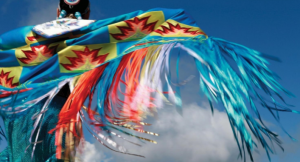Cultural Heritage Tourism Certificate Now Accepting Enrollments
In 2016, 57.2 percent (or 21.5 million) of the 37.5 million overseas visitors to the United States reported visiting an art gallery/museum, cultural/ethnic heritage site, historical location, national park or monument or other cultural site.
 Some 9 percent (or nearly 2 million) reported visiting an American Indian community.
Some 9 percent (or nearly 2 million) reported visiting an American Indian community.
These travelers, known collectively as Cultural Heritage Travelers, are a lucrative demographic for tourism marketers in the United States, as they report staying an average of 11.7 nights in a hotel or motel and feature an average (mean) household income of $79,246, according to research from the U.S. Department of Commerce’s National Travel & Tourism Office (NTTO.)
What’s more, their numbers are growing. Since 2009, the number of cultural heritage travelers from overseas markets has increased by more than 8 million (or 59 percent.)
As their numbers grow, so does their demand for genuine cultural experiences, posing a growing challenge for tourism professionals looking to tap into authentic local assets while also keeping abreast of the trends driving international tourism.
Hospitality and tribal tourism professionals, including tribal enterprises and entrepreneurs interested in opening a cultural tourism business, can tap into a wealth of detailed information by enrolling in the Professional Certificate in Cultural Tourism, offered by George Washington University in partnership with the American Indian Alaska Native Tourism Association (AIANTA.)
“The Montana Department of Tourism and Business Development has made the development of cultural tourism the highest priority when working with our tribal communities–on our seven reservations,” said Philip Belangie, Program Manager, Indian Country Programs, Montana Office of Tourism and Business Development, Department of Commerce.
“The Cultural Heritage Tourism Certificate courses have provided a strong foundation for strategic planning, developing community leadership, partnering with community organizations, assessment tools for individual programs and businesses, and marketing, especially how to utilize social media.”
The six-week certificate program is a self-managed online program that allows participants to learn the content and complete the requirements at their own pace. The program is comprised of six course modules, with one course scheduled per week during two three-week blocks. There is a one-week break between the two blocks.
“We would recommend this course to tourism professionals, both government and private sector at the state and regional levels of tourism and recommend to tribal organizations and individuals who are either deciding to make a commitment to support cultural heritage tourism or are engaged in tourism,” said Belangie.
Course modules for the six week program include:
Cultural Heritage Tourism
Examine the range of cultural heritage assets that can help to attract and engage visitors and drive economic development and cultural preservation. The curriculum covers best practices for effective community-based participatory planning, management and shared stewardship, which are all components of successful cultural heritage tourism.
Sustainable Tourism Assessment & Development
The rapid growth of tourism worldwide has created many challenges and opportunities for established and emerging destinations. This module focuses on conducting destination assessments to evaluate tourism potential and the costs and benefits of a sustainable tourism development program.
Community-Based Tourism
Participants are introduced to the issues and challenges involved in community-based tourism and learn the steps for planning and implementing their own program.
Destination Marketing
Marketing plays a strategic and critical role that in tourism development. Learn basic promotional techniques that can help to effectively sell a new or existing tourism product or destination.
Customer Relations for the Hospitality Industry
Outstanding customer relations is critical in the hospitality industry. Learn several strategies that can be used to deliver that level of service.
Best Practices in Event Management
Learn industry best practices on research, design, planning, coordination and evaluating a successful conference, meeting or event.
“I thoroughly enjoyed the six weeks of learning about Cultural Heritage Tourism,” said Dorothy FireCloud, Superintendent of Montezuma Castle and Tuzigoot National Monuments, National Park Service after completing the program in 2017. “Now that I have finished this course, I feel confident to be able to discuss with our tribal council different avenues which can be taken to develop a quality tourism destination program. I highly recommend the course for all who are involved in any aspect of tribal tourism!”
Program fees are $2,725 for AIANTA Members and $2,775 for non-members. The next program is scheduled for October 1- November 18, 2018/ Attendees must register by September 27, 2018.
For more information, contact Hannah Peterson, AIANTA Development Director at hpeterson@aianta.org or (505) 361-2168; or GWU at culturaltourism@gwu.edu.or register here.
About AIANTA
For more than two decades, the American Indian Alaska Native Tourism Association (AIANTA) has served as the national center for providing tourism and recreational travel technical assistance, training and capacity building to American Indian nations. AIANTA is a 501(c)(3) national nonprofit association of Native American tribes and tribal businesses and was incorporated in 2002 to advance Indian Country tourism. AIANTA’s mission is to define, introduce, grow and sustain American Indian and Alaska Native tourism that honors traditions and values.